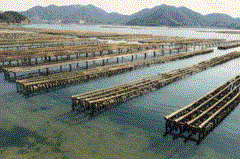

 |
||

|
Famous Center of Oyster Cultivation with
a History Stretching Back 400 Years
 Hiroshima Prefecture produces 25,000 to 30,000 tons of oysters per year. More than 80% is shipped out. Some of the products even finds its way to other countries. Oysters are also produced in Iwate, Miyagi, Niigata, Mie, Okayama prefectures, and elsewhere, but Hiroshima leads the pack by producing: about 60% of the national total. There are various accounts of the origins of oyster cultivation in Hiroshima, but the first written record can already be found as early as in the 16th century. Since then Hiroshima oysters gained a splendid reputation in the Edo period (1603-1868) as they were traded over a large area, including Osaka. In those days the cultivation method involved the use of branches to which bundles containing sprays of bamboo or twigs from coppiced trees were attached which are inserted in tidal flats . The oyster larvae would attach themselves to these branches, and could then be harvested after two or three years when they have grown to certain size. During the 1920s, a method of suspending oysters from raised shelves placed over tidal flats was established. Later, the cultivation method currently used was developed: oysters are suspended in the sea from rafts. Although this method was found a long time ago and that oysters would grow faster with this method, this method spread widely in the area only after the World War II. Because many of tidal flats that were formerly used for oyster rearing have been lost due to reclamation, the site of cultivation has had to shift further offshore. Photos: Oyster cultivation in Hiroshima Bay (Hiroshima Prefecture) Unauthorized reproduction of the
photos in this page is prohibited.
Related Links: |
|

